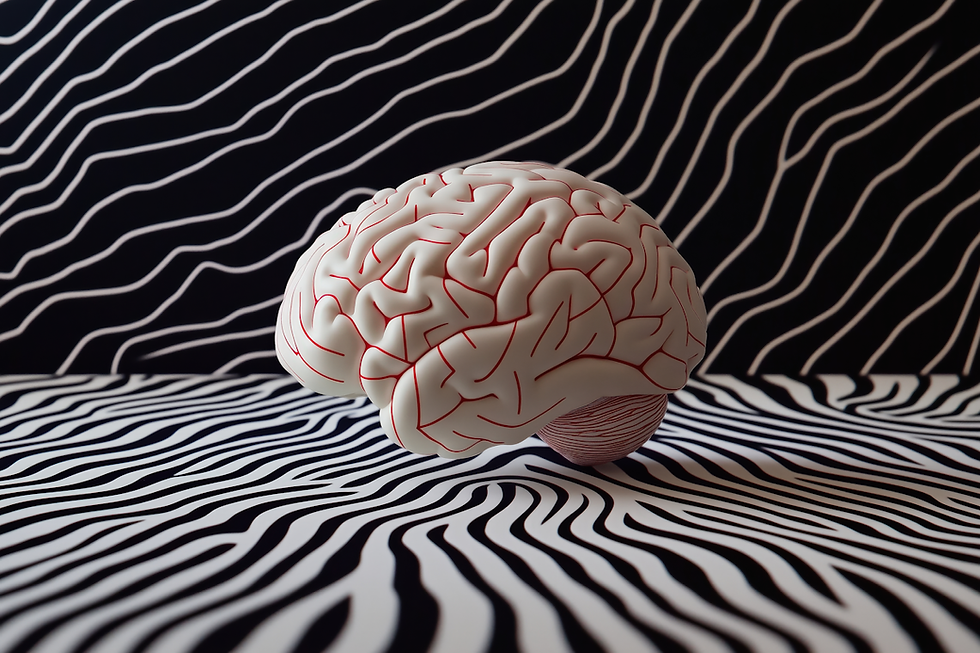Experiential Avoidance: The Mechanism That Keeps You From Healing
- Sabrina B.

- Sep 6
- 4 min read
This article is based on analyses of recent scientific journals concerning the functioning of the brain and therapies that aim to remodel it to treat mental disorders.
In our natural quest for happiness and comfort, we tend to run away from what bothers us. Whether it's an unpleasant emotion like sadness, an intrusive thought, or a painful memory, our first instinct is often to avoid it. This mechanism, known in psychology as experiential avoidance , is a universal defense strategy. While it may provide us with illusory relief in the short term, it is actually one of the main factors preventing deep healing. The paradox of avoidance is that the more we run away from our emotions, the stronger and more intense they become. They become shadows that follow us, insidiously, and prevent us from living fully.
"The paradox of avoidance is that the more we run away from our emotions, the stronger and more intense they become."
Psychedelic-assisted therapies represent a novel approach to treating mental health disorders by directly addressing a central defense mechanism: experiential avoidance. Avoidance, which involves avoiding unpleasant emotions, thoughts, or memories, is a key factor in maintaining symptoms, particularly in depression and PTSD. Psychedelics, when used in a rigorous therapeutic setting, act as a catalyst to help patients cope with and symbolize these inner experiences.
This article aims to explore this major psychological concept, explaining why experiential avoidance is a therapeutic impasse. It will show how psychotherapy offers a secure framework for "facing" and "welcoming" these inner experiences, thus transforming the fear of suffering into a path of resilience and freedom.

Experiential Avoidance: An Obstacle to Healing
Experiential avoidance is a universal defense strategy in which we seek to alter the form or frequency of our thoughts and emotions to escape suffering. While this may provide illusory short-term relief, this strategy traps suffering rather than resolves it because it prevents the natural process of healing and integrating painful experiences. For example, in depression, the Default Mode Network (DMN), responsible for mental rumination, is often overactive. This hyperactivity creates rigid thinking and incessant self-talk, which are forms of reality avoidance and the mental flexibility necessary for healing.
The Role of Psychedelic-Assisted Therapies
Psychedelic-assisted therapies are designed as a direct response to experiential avoidance. They are not simply substance use, but a structured psychotherapeutic process that leverages the neurobiological and psychological effects of these molecules. The typical process includes preparation sessions, the dosing session, and, crucially, post-experience integration sessions.
Brain "Reset" and Plasticity : Classic psychedelics, such as psilocybin, disrupt the activity of the MDR, decreasing its internal connectivity and inducing a state of brain hyperplasticity. This state, often described as a brain "reset," offers a unique window of opportunity where the brain is more malleable and can form new neural connections. This increased flexibility makes psychotherapeutic work more effective in reshaping rigid thought patterns and breaking the cycle of avoidance.
Confrontation and Symbolization : The psychedelic experience itself helps patients cope with their emotions and traumas. Indeed, it can cause profound alterations in consciousness that allow for the reprocessing of memories without the usual emotional overload. The patient can then confront the emotions they have spent years avoiding. Post-session integration is the therapeutic work of making sense of these experiences, a process called symbolization or "narrative work." This work is essential for transforming a difficult experience into a time of growth and learning, and for reducing experiential avoidance in the long term.
Set and Setting : The effectiveness and safety of these therapies depend crucially on set and setting. The patient's set (state of mind) and setting (the therapeutic environment) are determining factors for the quality of the experience and the clinical outcome. A secure setting and clear intention allow the patient to use the experience for healing rather than avoidance.
Although psychedelic-assisted therapies work in a unique way by creating a window of neural plasticity to rewire the brain, they share a common goal with other therapeutic approaches: helping individuals change their relationship with their difficult emotions. Cognitive behavioral therapy (CBT) , for example, uses graded exposure to teach the brain that feared situations or emotions are not as threatening as it imagined, thus breaking the vicious cycle of fear and avoidance.
Similarly, mindfulness , by encouraging the observation of one's thoughts and emotions without judgment, allows one to realize that even intense feelings are fleeting, reducing the impulse to escape them. Narrative work , on the other hand, helps integrate painful experiences into the patient's life story, transforming trauma into a source of strength. These approaches, although distinct in their mechanism of action, all contribute to creating new neural pathways that replace old escape patterns.
Conclusion
Psychedelic-assisted therapies are powerful tools for countering experiential avoidance by creating a window of plasticity that facilitates the therapeutic work of symbolization. They offer a fascinating glimpse into how psychotherapy can help transform suffering into a source of lasting growth. By providing a structured and secure framework, these therapies allow patients to confront what was once too painful, opening the way to profound healing and a new relationship with their own inner experiences.
What emotion are you having the most trouble embracing? Do you think it's time to make room for it so you can move forward? If you'd like to explore these questions and begin working on resetting your mind, I offer online coaching sessions from Monaco to guide you on this path.
Sources:
Berkovitch, L. (2021). Psychedelics, psychotherapy and symbolization: a literature review in the field of depression. L'Évolution Psychiatrique, 86(3), 565–577.
Fauvel, B., et al. (2021). [Efficacy of psychedelics in psychiatry: A systematic review]. L'Évolution Psychiatrique, 86(3), e1-e12.
Berkovich, L. (2021). [Efficacy of psychedelics in psychiatry, a systematic review of the literature]. L’Encephale, 47(4), 376–387. doi: 10.1016/j.encep.2020.12.002.
Flourish Mindset. (2024, August 12). The crucial role of set and setting in psychedelic-based therapy. https://www.flourishmindset.com/the-blog/the-crucial-role-of-set-and-setting-in-psychedelic-based-therapy
University of California, Berkeley. Psychedelics and the Default Mode Network. https://psychedelics.berkeley.edu/resources/psychedelics-and-the-default-mode-network/
University of California, Berkeley. Set, setting, and clinical trials: colonial technologies and psychedelics. https://psychedelics.berkeley.edu/resources/set-setting-and-clinical-trials-colonial-technologies-and-psychedelics/
Keywords: Experiential avoidance, psychotherapy, psychedelics, anxiety, depression, mindfulness, CBT, narrative work, neuroplasticity, Monaco
Art by : Binks AI






Comments